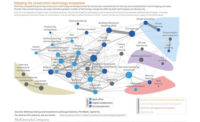Construction technology leaders and software developers are preparing for a massive storm of innovation as the industry moves its data and processes to the cloud. The trend is breaking down data silos and opening company operations to penetrating, real-time analysis of the rivers of data flowing from traditional software processes, as well as newer ones supported by an explosion of field-collected data and mobile devices. The data is revealing how construction actually works and how projects really get built.
“In the next five years, the industry is going to be transformed through data. It’s an unprecedented, perfect storm of cloud, mobility and an incredible amount of collectors and data science converging together,” says Pat Keaney, director of BIM 360 Enterprise Products at Autodesk. “It’s really going to move the needle in ways we couldn’t have dreamed of five years ago.”
The delivery of construction software and services via the internet, or software as a service (SaaS), exposes the industry’s vital signs. Developers say data patterns are emerging that can improve software, designs, project management, supply chains and safety. And the magic is only just getting started.
Early benefits—all in development or pilots now—will include real-time sensor-based production feedback to help craftworkers streamline processes; predictive assessments to warn superintendents every morning of specific risks likely to arise that day; jobsite defect and safety-hazard flagging that is automatically derived from a background analysis of job-cam, smartphone and drone imagery, and performance-based contractor safety ratings that feed directly into each company’s personal insurance-rate calculations.
And that doesn’t include the gains of producing better designs by drawing recommendations from the post-construction outcomes of thousands of previous designs. Ever more accurate estimating, using vast amounts of connected data and experience, also is among many advantages experts say are starting to rain from the cloud.
“We have been meeting once a week for months to decide what the collective management strategy should look like to develop a business intelligence capability robust enough to meet the market,” says Tobias

“The only reason I came to construction is that there is so much potential for improvement.”
–Tobias Person, Hill International
Person, vice president and director of corporate strategic development at Hill International. Person recently moved to Hill from a biometrics and forensics job at NATO, developing watch lists for terrorists. At NATO, “tracking and discovery in patterns became automated,” he says. “The only reason I came to construction is that there is so much potential for improvement.”
Anthony Colonna, senior vice president of innovation and construction solutions at Skanska, says Skanska leaders are in deep discussions about what they call their “digitalization strategy. It’s all about information and data,” Colonna says. Skanska is looking at how it uses “big data” to better engage clients, create new markets and improve operations. “How do we innovate just by learning to see through this sea of data? How do we reveal how we are working?” Colonna asks.
Building Clouds
Talking to software developers, whose world is getting rocked to its foundations, is the first step in discovering where the shift to the cloud is leading.
Thomas Wolf, chairman of RIB Software AG, says, “I 100% believe that SaaS, cloud-based BIM, the internet of things [IoT], 5D, big data, and end-to-end enterprise technology and platforms will replace 80% of the client-server or desktop silo technology used today.” RIB’s products are built around cloud-based BIM management and estimating. “Data silos will be replaced by single source-of-truth, big-data solutions that can run smart analytics to optimize processes,” he predicts, adding that he believes very few traditional software product lines will survive. “Most software companies have not the financial and human power to develop a complete new software that can fulfill the SaaS needs,” he says.
The shift to SaaS has been underway for years. Another trend is connecting data across the offerings of the primary vendor but also with the tools of third parties. The growth of connected data and data created as a by-product of the traffic and processing—some call it “exhaust data”—is getting interesting.
“There’s been this kind of perfect storm of all these data sources coming together with people really using mobile products,” says Keaney. She credits the iPad as a game changer because it brought data to the jobsite. “After the iPad, mobility, cloud and now this accumulation of data with the data science that can be applied, it’s really changing everything.”
A mind-meld of sensor data, real-time positioning and analytics also is making a promising contribution. In a pilot project just completed on an institutional project that included the construction of 50 modular bathrooms, Skanska and start-up technology companies Rhumbix and Redpoint tracked the movements of plumbers and electricians as they fetched materials and assembled the modules. Live feedback given directly to the on-site craftworkers led them to improve their processes day after day and reduce the assembly time required for the modules to 17 hours from 41 hours.

“It’s an unprecedented, perfect storm of cloud, mobility and an incredible amount of collectors and data science.”
–Pat Keaney, Autodesk
Eighteen months ago, Autodesk quietly started building a data science group, which Keaney leads. “These folks are expert at understanding data, at what you can understand from data and how to avoid [assumption] traps that those of us who are less skilled may make,” Keaney says.
Keaney’s team is developing new products built around “surfacing” actionable information from the sea of data. The first, which Keaney says “is on the horizon,” will give superintendents a daily prediction of risks likely to arise, given the schedule, the work packages and the performance history of the subs in thousands of previous instances. In the pipeline is a product that analyzes jobsite images in the data stream to spot defects and safety issues and automatically warn contractors.
Exhaust data can include a world of anonymous information from which inferences can be drawn about industry trends and best practices. Harry Vitelli, senior vice president of project delivery at Bentley Systems Inc., says Bentley has been on that analysis path since 2003, when the company launched its “Select Server” SaaS-supported software subscription program.
The patterns of use have led to “playbooks and playlists,” which are context-sensitive tool-set suggestions, based on usage by all customers doing similar projects in recent years, that clients may find most useful as they set up projects.
Vitelli says Bentley now is looking at anonymous ProjectWise data and usage patterns to search for “success signs” and push recommendations back to users.

“We have the system in place. We will start providing some data at an organizational level in the next six months so.”
–Ram Pratti, Bentley Systems
Ram Pratti, division head for Bentley’s CONNECT Platform, says users are mining their own data to try to answer questions about what’s happening in their projects, what is likely to happen and what they should do about it. “This can help them to understand their process efficiencies and inefficiencies,” he says. Pratti says Bentley also is developing content-based insight for designers, recommending the best components based on data about repairs and replacements from operations and maintenance at functioning facilities. “We have the system in place. We are collecting that kind of information now, and we will start providing some data at an organizational level in the next six months or so,” Pratti says.
Data Savvy
Vitelli says, “Our users are going to be getting data-savvy. Today, only a handful of companies have data analysts on staff, but that will become commonplace, not only with the vendors but with the users.”
Rob Phillpot, senior vice president for product and engineering and cofounder of cloud-based project, document and communications management vendor Aconex, says he is seeing “disruptions,” including a move to field-based processes, BIM, sensors and the IoT, and financial technology, as well as a move to data management from file management. “What is common across all of these elements is the increasing capture of rich data,” says Phillpot.
Phillpot says that, early in a project, Aconex is mining past project data to create machine-learning algorithms to find warning signs that suggest when there are information deficiencies likely to exacerbate problems months away. “We are working on ways to look at data and patterns from past projects—and whether they were successful or not—to help predict when an existing project may be heading off the rails,” he says. If a project manager is given advance warning that something is about to go wrong, then he or she can do something. It could make the difference between a project “blowing up” or progressing to a “successful delivery,” he says.
Phillpot says Aconex has served more than $1 trillion in projects and nearly 70,000 user organizations in more than 70 countries during the past 15 years. “With this data set, we see an amazing opportunity to provide insights for our users,” he says.
Many indicators show the shift to the cloud is speeding up. Assemble Systems provides construction data management solutions with Assemble Insight, a cloud-based platform designed to help firms leverage BIM and other design and engineering data for project insight, estimating, collaboration and data-driven decision-making. Don Henrich, chief operating officer, says more than 100 construction firms are using Assemble to manage more $50 billion in projects, following a steady growth trend going back to the launch in 2013 (see chart p. 27).

“A data-centric view of projects will expand to a macro-view of the industry.”
–Don Henrich, Assemble Systems
“Our users are conditioning design information for constructibility to quantify and organize BIM data for pre-construction,” Henrich says, adding that the pre-construction data sets are becoming a foundation for extending the use of the data through systems-level integration with estimating, scheduling and project management systems. “We are seeing the beginnings of a data-centric worldview in construction that is starting at the project level but will rapidly encompass a macro-level view of the industry,” Henrich predicts.
“Taking into account the number of projects being added to cloud-based solutions today—whether document sharing, bid-management or project management solutions—the adoption is beginning to represent the critical mass required to drive meaningful analytics around industry trends,” Henrich adds. The biggest impediment, he says, are the data sets still in silos that are not connected in an intelligent system.
Procore Technologies Inc. also offers a cloud-based construction management system. Client companies pay at a rate pegged to their annual construction volume and then may add as many users as they please, including external partners and subs, which further grows the data trove. The company has pulled in venture capital in several rounds over its 13-year life, growing to more than 600 employees today from 35 employees two years ago. The user base has just surpassed 1.4 million.
“The influx of tailor-made collaborative tools and cloud-based [SaaS] into the previously low-tech world of construction has been remarkable,” says Sam Crigman, Procore CTO, in a blog now being drafted for publication. “Data is constantly streamed to servers from construction projects all over the world. This wealth of construction-related data contains invaluable lessons, including starts and stops and best-practice rethinks. The economies of building can be rewritten if those rich mega-datasets of processing power can be properly harnessed and deployed.”









Post a comment to this article
Report Abusive Comment